for Defence and Security Studies The Russian Air War and Ukrainian Requirements for Air Defence Jus%n Bronk with Nick Reynolds and Jack Watling Special Report 7 November 2022

Bronk with Reynolds and Watling Contents Execu%ve Summary 1 Introduc2on 3 I. Russian Fixed-Wing Combat Opera2ons 7 II. Russian AAack Helicopter Employment and Performance 30 III. Russia’s Long-Range Strike Campaign: Cruise Missiles, Ballis2c Missiles and 36 Loitering Muni2ons 36 IV. The Need for More Western Aid to Improve Ukrainian Air Defence 52 About the Authors 61
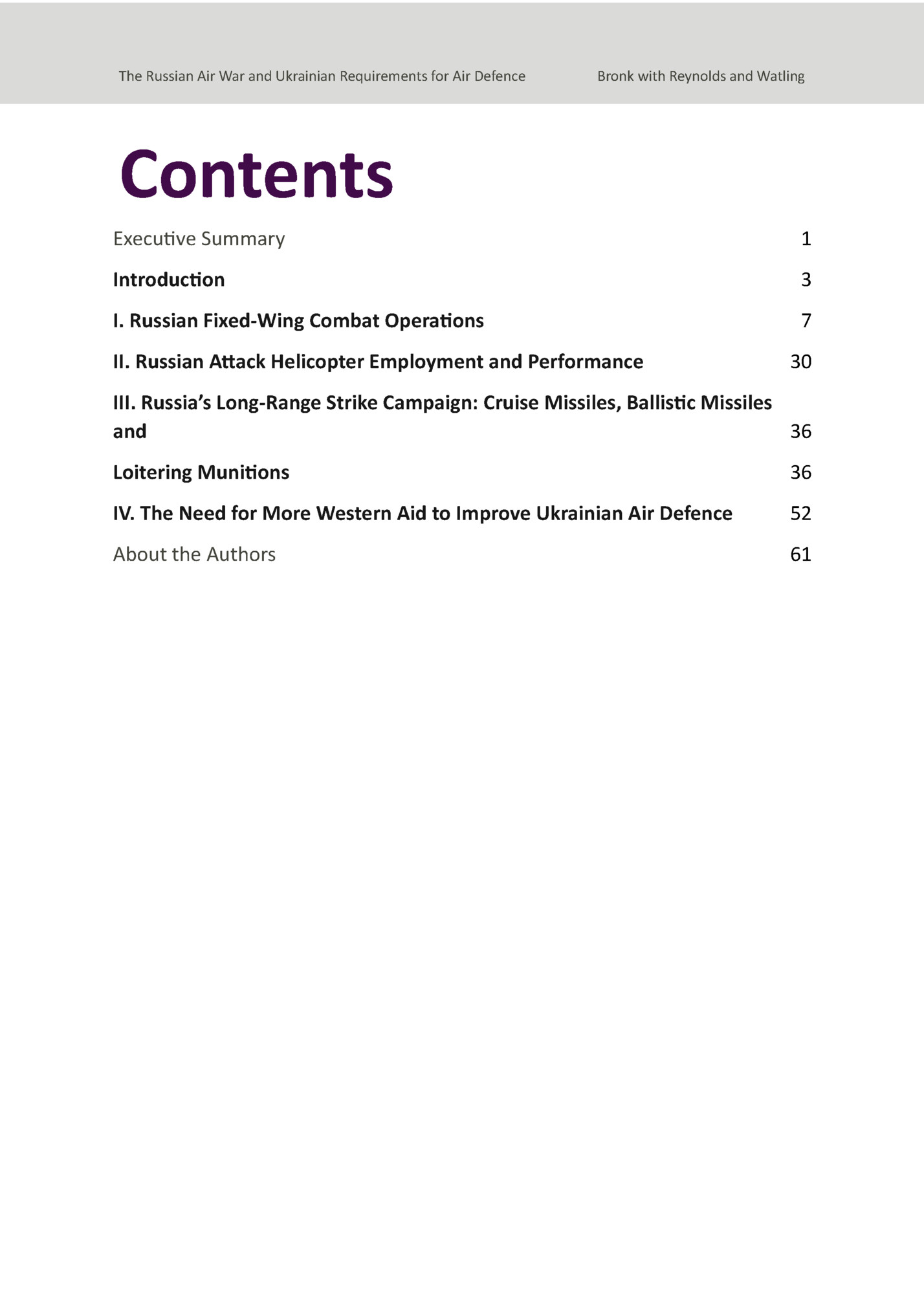
Bronk with Reynolds and Watling Execu,ve Summary • • • • • • • Russian Aerospace Forces (VKS) conducted significantly more extensive fixed-wing strike opera%ons during the first days of the invasion than has been previously documented, while Ukrainian ground-based air-defence (GBAD) capabili%es were suppressed by ini%al aTacks. During this period, Ukrainian fighter aircraV inflicted some losses on VKS aircraV but also took serious casual%es due to being totally technologically outmatched and badly outnumbered. Russian fighters have remained highly effec%ve and lethal against Ukrainian aircraV near the frontlines throughout the war, especially the Su-35S with the R-77-1 long-range missile and, in recent months, the Mig-31BM with the R-37 very long-range missile. From early March, the VKS lost the ability to operate in Ukrainiancontrolled airspace except at very low al%tudes due to its inability to reliably suppress or destroy increasingly effec%ve, well-dispersed and mobile Ukrainian surface-to-air missile (SAM) systems. Russian GBAD has also been highly effec%ve since March, especially the longrange S-400 SAM system supported by the 48Ya6 ‘Podlet-K1’ allal%tude long-range surveillance radar system. Numerous man-portable air-defence systems (MANPADS) provided to Ukrainian troops and later mobile air-defence teams meant that lowal%tude Russian fixed-wing and rotary penetra%ng sor%es beyond the frontlines proved to be prohibi%vely costly during March, and ceased by April 2022. Throughout the war, most Russian airstrikes have been against predesignated targets with unguided bombs and rockets. The Su-34 fleet has regularly also fired standoff missiles such as the Kh-29 and Kh-59 against fixed targets, and Su-30SM and Su-35S fighters have regularly fired Kh31P and Kh-58 an%-radia%on missiles to suppress and target Ukrainian SAM radars. 1
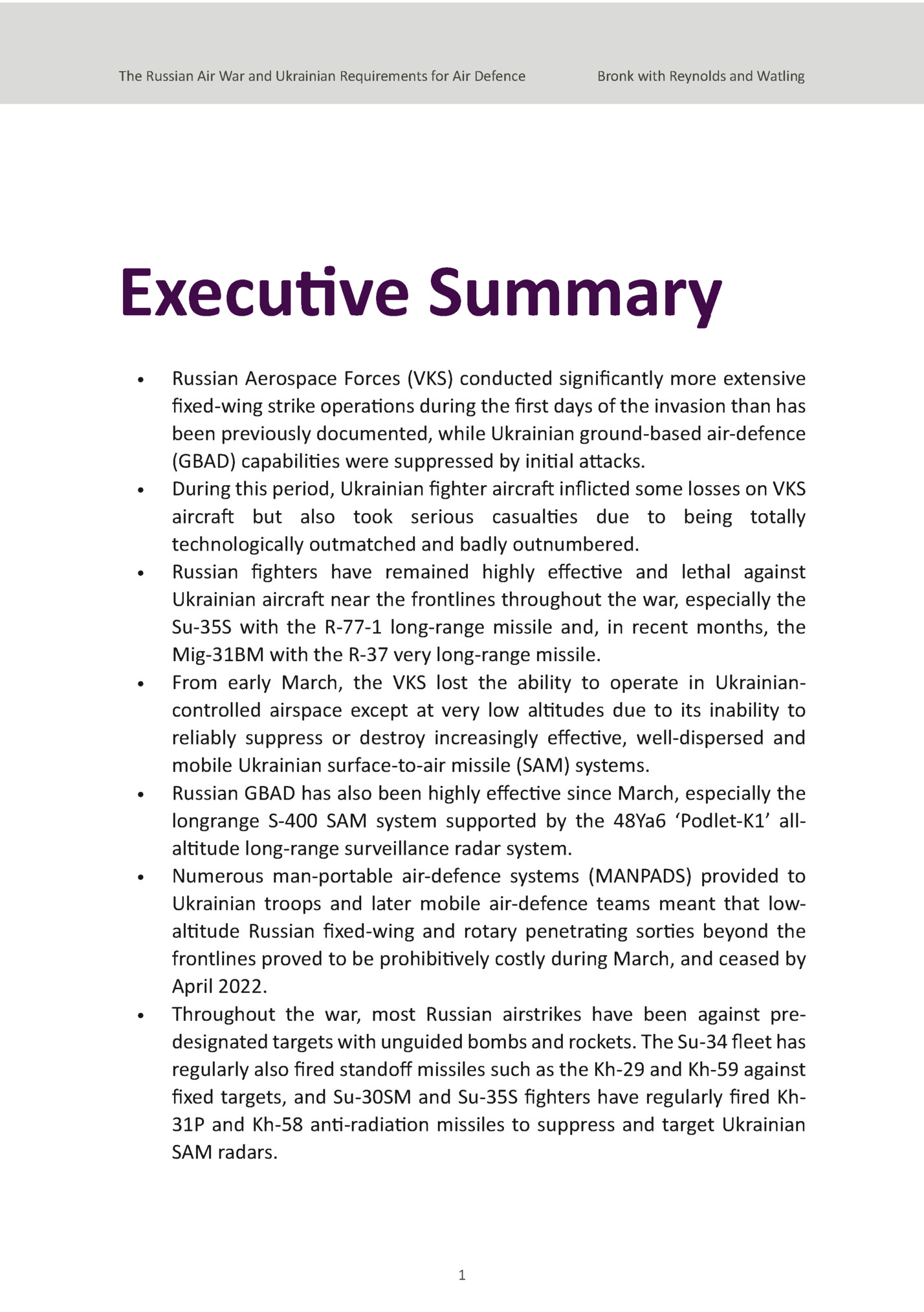
• • • • • • • Bronk with Reynolds and Watling Without air superiority, Russia’s aTempts at strategic air aTack have been limited to expensive cruise and ballis%c missile barrages at a much more limited scale. These failed to achieve strategically decisive damage during the first seven months of the invasion. However, the latest itera%on is a more focused and sustainable bombardment of the Ukrainian electricity grid, blending hundreds of cheap Iranian-supplied Shahed-136 loitering muni%ons against substa%ons with con%nued use of cruise and ballis%c missiles against larger targets. The West must avoid complacency about the need to urgently bolster Ukrainian airdefence capacity. It is purely thanks to its failure to destroy Ukraine’s mobile SAM systems that Russia remains unable to effec%vely employ the poten%ally heavy and efficient aerial firepower of its fixedwing bomber and mul%-role fighter fleets to bombard Ukrainian strategic targets and frontline posi%ons from medium al%tude, as it did in Syria. It follows that if Ukrainian SAMs are not resupplied with ammuni%on, and ul%mately augmented and replaced with Western equivalents over %me, the VKS will regain the ability to pose a major threat. In the short term, Ukraine also needs large numbers of addi%onal MANPADS and radarguided an%-aircraV guns, such as the Gepard, to sustain and increase its ability to intercept the Shahed-136s and protect its remaining power infrastructure and repairs to damaged facili%es. In the medium term, Ukraine needs cost-effec%ve ways to defend itself against the Shahed-136. One op%on could be compact radar and/or laser ranging and sigh%ng systems to allow numerous exis%ng an%-aircraV guns to be much more accurate and effec%ve against them. The Ukrainian Air Force fighter force needs modern Western fighters and missiles to sustainably counter the VKS. Russian pilots have been cau%ous throughout the war, so even a small number of Western fighters could have a major deterrent effect. Any Western fighter supplied in the short–medium term needs to be capable of dispersed opera%ons using mobile maintenance equipment and small support teams, and flying from rela%vely rough runways, to avoid being neutralised by Russian longrange missile strikes. 2
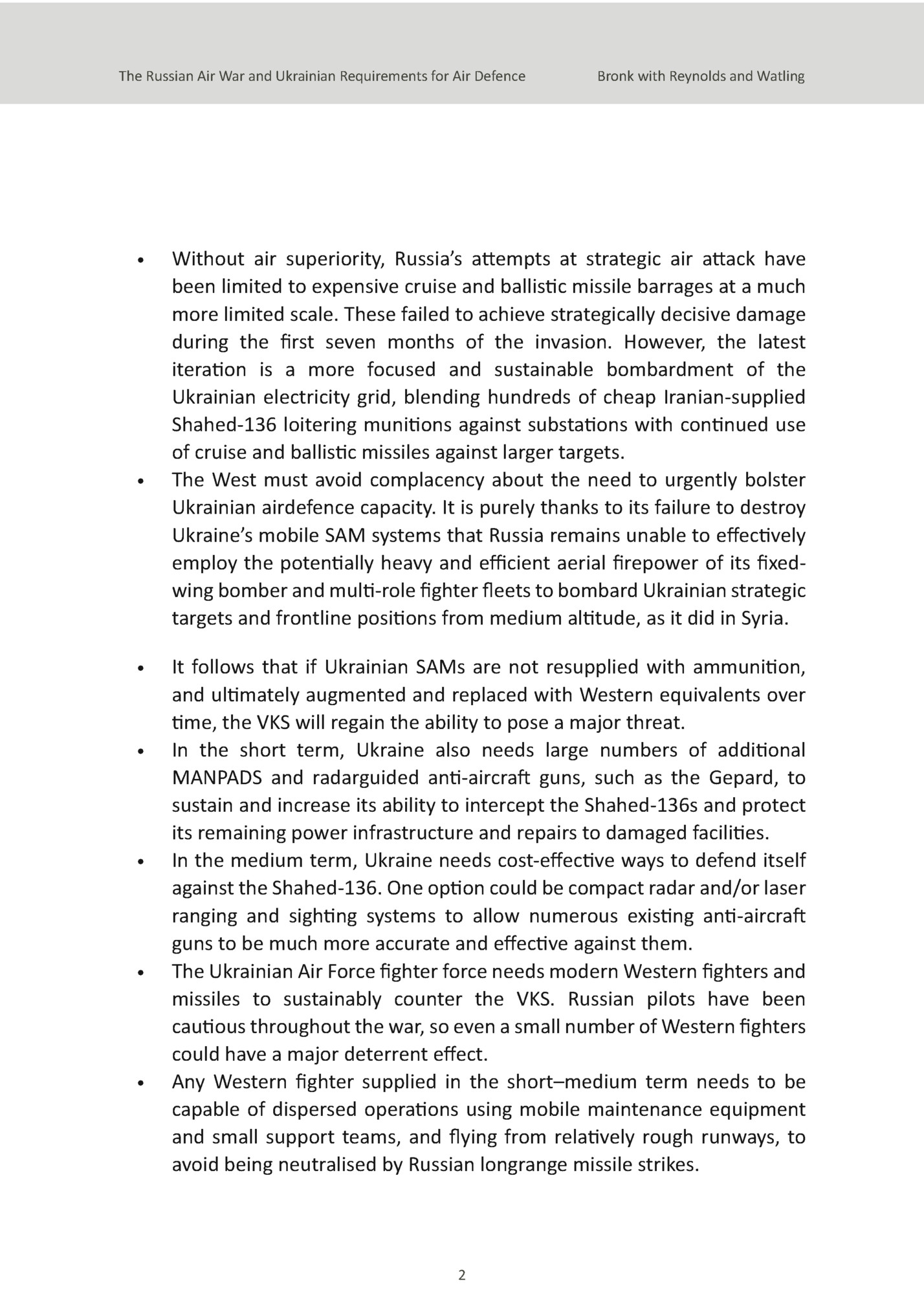
Bronk with Reynolds and Watling Introduc,on W HEN RUSSIA BEGAN its full-scale invasion of Ukraine on 24 February 2022, it ini%ated the first large-scale peer conflict in Europe since the Second World War. The stakes are extremely high, as the outcome of the war will define not only the future of Ukraine and of Russia, but also the global geopoli%cal system. Unsurprisingly, therefore, there has been an unprecedented degree of sustained global public, poli%cal, military and media interest driving external analysis of the war. Since the start of the invasion, military analysis in both public and professional communi%es has focused heavily on Russia’s employment of ground forces.1 This is logical since the Russian Ground Forces have done by far the most damage, possess most of Russia’s conven%onal firepower and are the most important component of Russian military capability. By contrast, Russian Aerospace Forces’ (VKS) fixed-wing and helicopter opera%ons during the conflict have remained more sparsely documented and only par%ally understood outside those Ukrainian Air Force, Navy and Army personnel directly involved in countering their opera%ons dayto-day. External analysts, including the lead author of this report, have so far focused on trying to explain the apparent absence of a large-scale air campaign or strategically significant results achieved by the VKS.2 The pervasive use by both sides of small unmanned aerial systems (sUAS) – usually called ‘drones’ – and UAVs – also usually called ‘drones’ – carrying modern cameras, and the ubiquitous presence of smartphones among troops, has ensured that detailed footage of the 1. For examples, see Jack Watling and Nick Reynolds, ‘Ukraine at War: Paving the Road from Survival to Victory,’ RUSI Special Report, 4 July 2022; Michael Kofman and Rob Lee, ‘Not Built 3
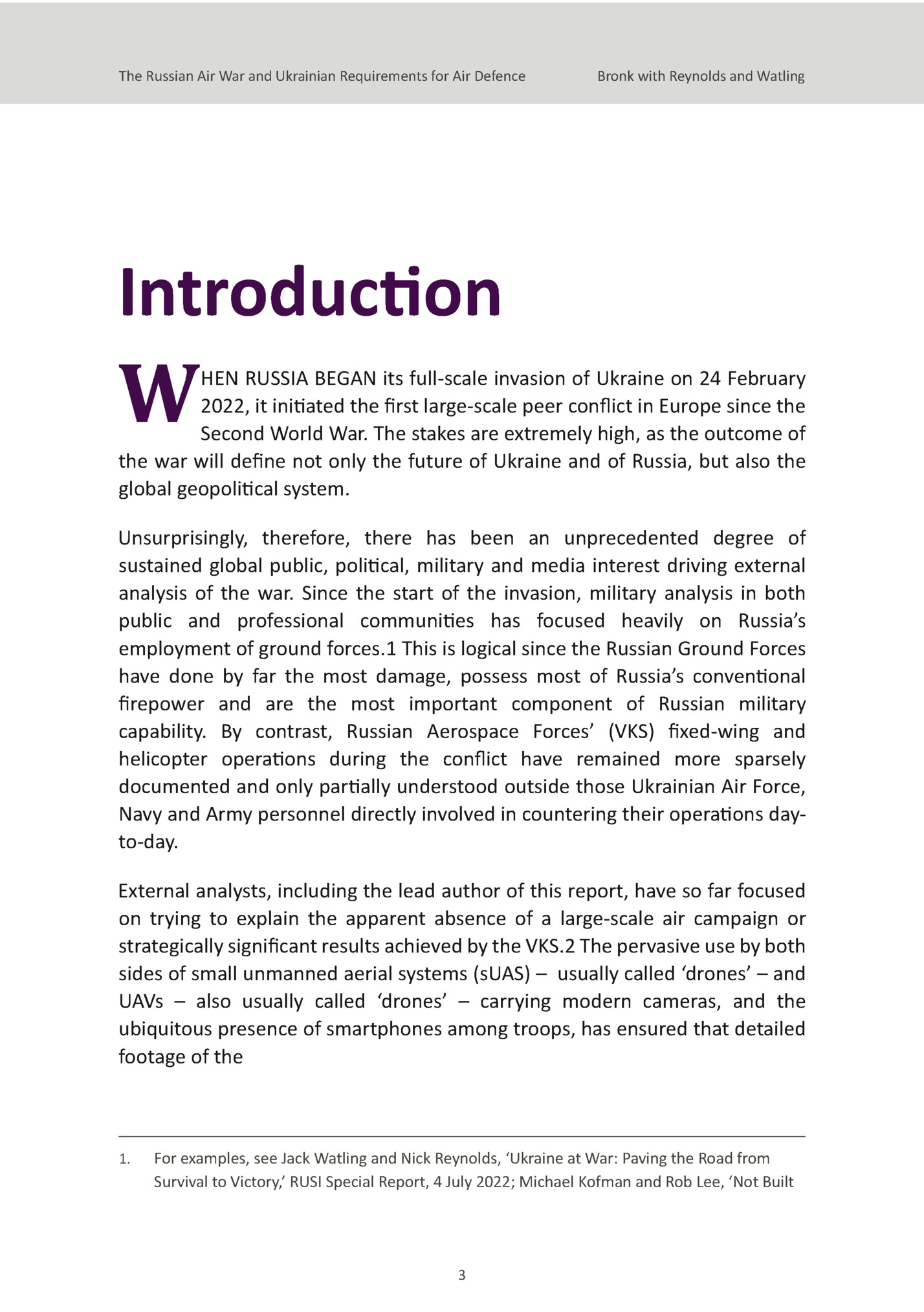
2. Bronk with Reynolds and Watling for Purpose: The Russian Military’s Ill-Fated Force Design’, War on the Rocks, 2 June 2022; and assessments and maps updated each day at InsRtute for the Study of War, ‘Ukraine Conflict Updates’,
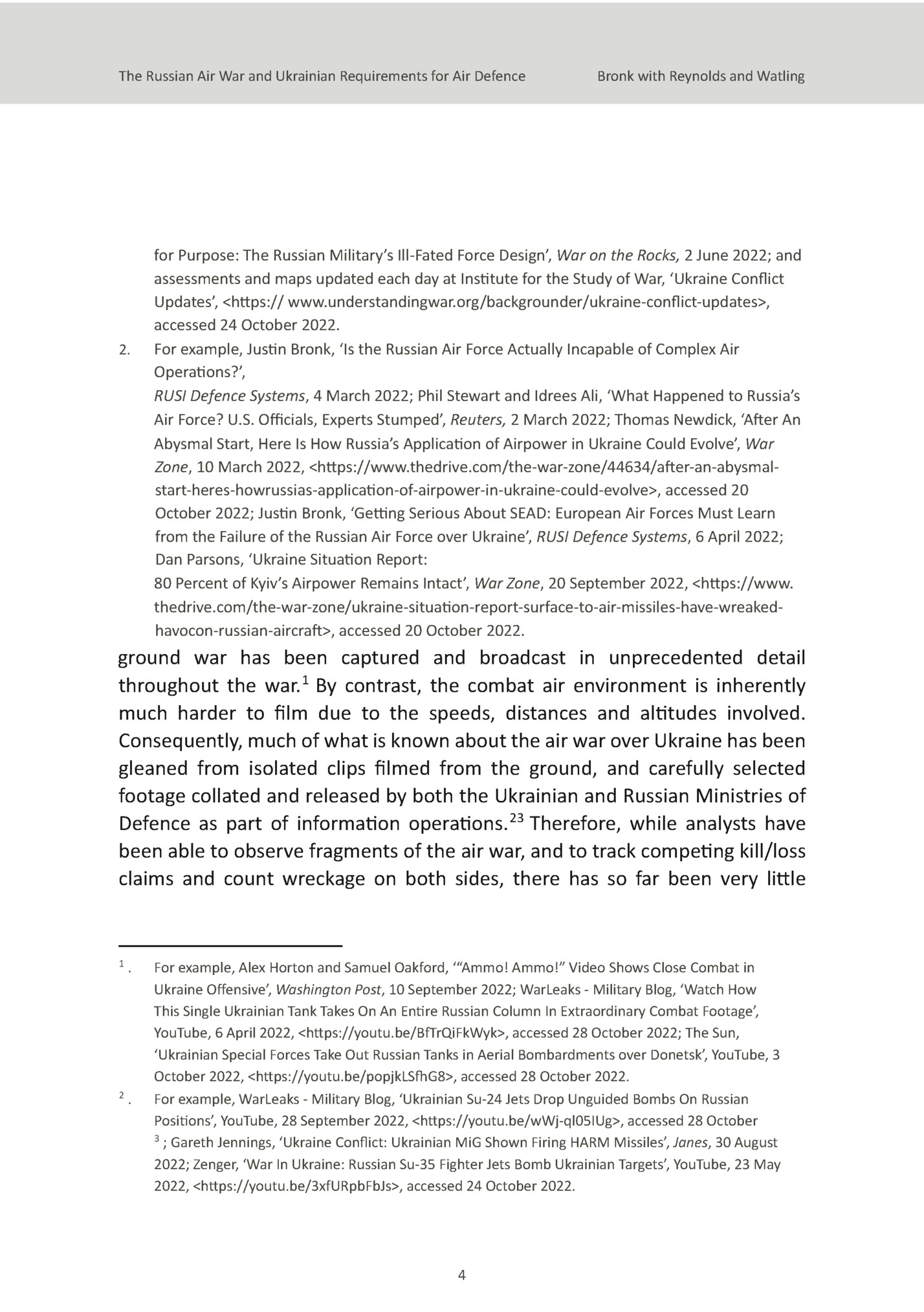
Bronk with Reynolds and Watling granular informa%on available in the public domain about the actual Russian air war over Ukraine.4 This report sets out to start the process of uncovering how Russia’s VKS has operated over Ukraine between the start of the invasion in February and late October 2022. It is based on fieldwork conducted in Ukraine in August and October 2022, which included interviews with Ukrainian Air Force officers working in both the avia%on and air-defence branches, interviews with senior intelligence officers and military scien%sts, and examina%on of captured and recovered Russian weapons systems. To protect sources, the interview subjects have been anonymised and precise dates and loca%ons are not disclosed. The interviews were, of necessity, conducted with Ukrainian officials and officers but not Russian ones and, consequently, they represent an incomplete view from only one side of the air war. To guard against over-reliance on single sources, most of the interviews were conducted with mul%ple individuals represen%ng different parts of their services. Where possible, informa%on has also been cross-referenced between different interviews, and also evaluated against externally available footage and exis%ng opensource intelligence data. Chapter I provides details of the opera%ons undertaken by the fixed-wing fighter, fighterbomber and aTack aircraV of the VKS. There were significant changes in objec%ves, tac%cs, opera%onal intensity and weapons use at various phases of the war, so this chapter takes a chronological approach to explain their evolu%on over %me. Chapter II examines Russian aTack avia%on (helicopter gunship) opera%ons during the war. Chapter III examines the Russian longrange precision-strike campaign, looking at the paTerns of use, targets and some characteris%cs of the cruise and ballis%c missiles Russia has used to bombard Ukraine. It also provides some analysis of the Iranian-supplied Shahed-136 (called Geran-2 by Russia) loitering muni%ons (oVen inappropriately called ‘kamikaze drones’) that have been extensively used 4 . The most comprehensive publicly available database on Russian aircral losses in Ukraine is: SYjn Mitzer with Joost Oliemans, ‘List of Aircral Losses During the 2022 Russian Invasion of Ukraine’, Oryx, 20 March 2022,
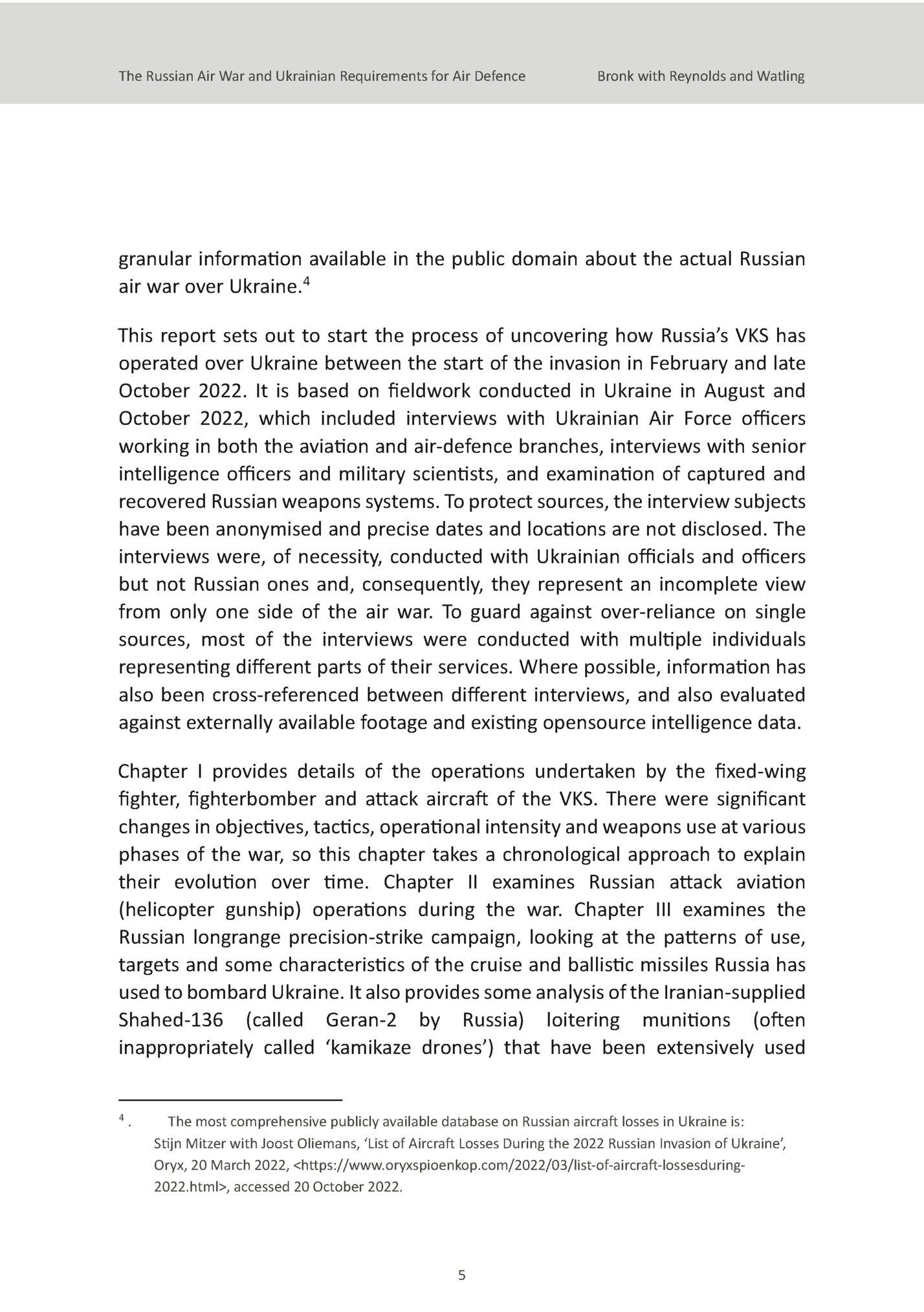
Bronk with Reynolds and Watling against Ukrainian infrastructure since September 2022. Finally, the report concludes with an analysis of the main priori%es for aid that Ukraine needs from its interna%onal partners to improve its air-defence capabili%es. There are several areas that are already becoming cri%cal requirements if Ukraine is to sustain the baTlefield momentum that it has won over Russia at such a devasta%ng cost since February 2022. The report deliberately avoids giving detailed descrip%ons of Ukrainian air combat and groundbased air-defence (GBAD) tac%cs, opera%ons and losses to protect Ukrainian opera%onal security. As such, it does not aTempt to give a comprehensive or final account of the air war, but rather to usefully increase Western understanding of the use of Russian airpower during the conflict within the bounds of what can be verified and publicly discussed at this stage. 6

Bronk with Reynolds and Watling I. Russian Fixed-Wing Combat Opera,ons T HE IMPACT OF hundreds of Russian cruise and ballis%c missile strikes across Ukraine and the ill-fated air-assault opera%on at Hostomel Airport dominated the external view of Russian air opera%ons during the ini%al week of the invasion.6 Ukrainian fast jets flew several visible combat air patrols (CAPs) over Kyiv and other ci%es, but various viral pieces of footage claiming to show air-to-air combat between Russian and Ukrainian jets were quickly recognisable as fakes created using commercial flight simulator soVware.7 This led several commentators, including the lead author of this paper, to put forward various theories for the apparent absence of VKS ac%vity during the first week of the invasion.8 The VKS had deployed a fast-jet force of around 350 modern combat aircraV for opera%ons in Ukraine; so the lack of a publicly visible air campaign came as a major surprise to most analysts.9 The tenta%ve conclusions reached by this author in March about the lack of VKS capacity to mount complex, large-scale opera%ons s%ll hold today, but early analysis was wrong about the lack of significant Russian air ac%vity in the early days of the war.10 This chapter explains how, in fact, the VKS mounted significant strike and offensive counterair opera%ons during this period, and the Ukrainian Air Force engaged in numerous air-to-air clashes to oppose it.11 6. 7. For example, Natalia Zinets and Aleksandar Vasovic, ‘Missiles Rain Down Around Ukraine’, Reuters, 25 February 2022; and David Hambling, ‘Russia Invades Ukraine: Missiles And MisinformaRon’, Forbes, 24 February 2022. For example, see links in Joe Skrebels, ‘Video Game Footage Falsely Presented as Videos of Ukraine War’, IGN, 25 February 2022. 7
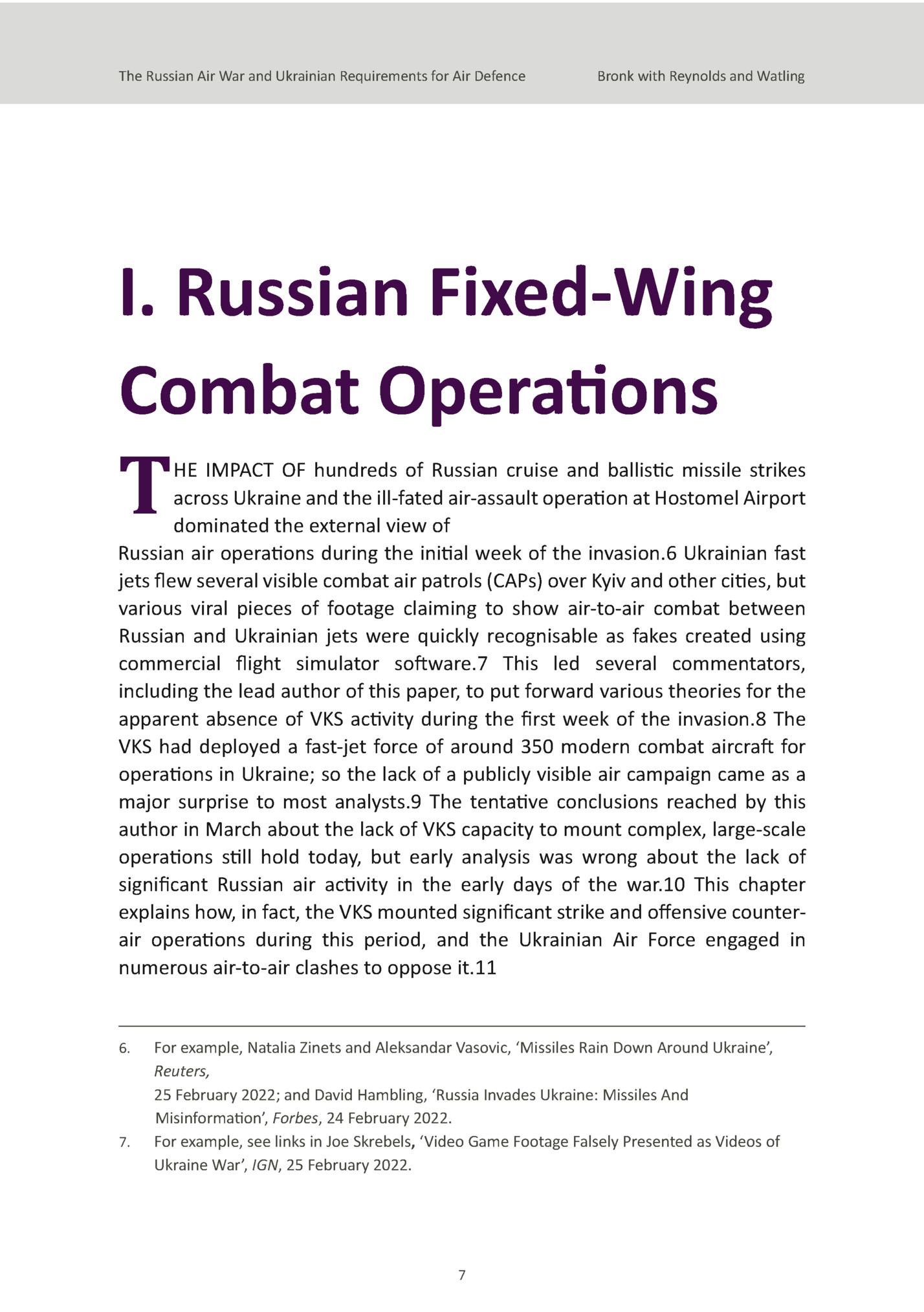
Fleepit Digital © 2021